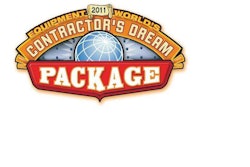Cash-only policy gives leg up on equipment buys, bonding
By Marcia Gruver Doyle
 Scot Matlock (left) and Larry Davis.
Scot Matlock (left) and Larry Davis.These actually are good times for L.E. Davis Construction, Harrison, Arkansas. From 2007 until now, President Larry Davis has managed to grow his annual revenues from $3.5 million to almost $14 million and his employees from 15 to 31 – but not without a lot of extra effort. “I work 14 hours a day now instead of 12,” he says.
One move that has definitely made a difference: hiring a knowledgeable mechanic. It has allowed him to take advantage of the excellent used equipment deals that were prevalent in the early part of the recession. Paying off his debt, he’s maintained a cash-only position, buying used equipment solely since early 2008. “If it’s paid for, we don’t have to worry about it being parked,” he explains. He’s almost doubled his fleet in the past few years using this strategy, rolling profits into equipment buys.
The company’s liquidity has put it in a strong position with its bonding company. It didn’t have to dip into its lines of credit and was able to get its bond rate cut in half. Crediting his general manager and son-in-law Scot Matlock with recognizing people’s strengths, Davis says he’s also been able to cherry-pick management from area contractors who didn’t make it. “We’ve got the best team ever. I credit Scot with our growth as much as myself. Without his drive and natural instinct for the business, it couldn’t have happened.”
Computer time is now part of his daily process. “I had to stop hanging out at the coffee shop and spend a good part of the day looking for work,” Davis says. He also searches out equipment deals – and with the exception of one excavator – has bought every machine in the past three years over the Internet. “We discuss each buy with the team and exercise restraint, deciding what we’ll pay for a machine and not going above it.” But he knows the used deals may come to an end. “You can’t depend on them to be there forever.”
At the start of the recession, L.E. Davis Construction had a project mix of 40 percent residential, 30 percent underground utilities and 30 percent commercial buildings. Now most of the commercial work has been replaced by government-funded housing and the rest of the mix is 20 percent residential/50 percent underground utilities. “We’re doing a lot more senior housing and sewer lines than we did in 2007,” Davis says, “but we’re bracing for a government-spending slowdown.”
And about those 14-hour days – that applies to others on Davis’s team. “We pay a ton of overtime around here,” says Equipment World’s 2009 Contractor of the Year. “We consider it a necessary evil. We’ve got the theory if a guy is willing to work more hours, it’s better than hiring more people, especially with equipment operators who require another machine.”












